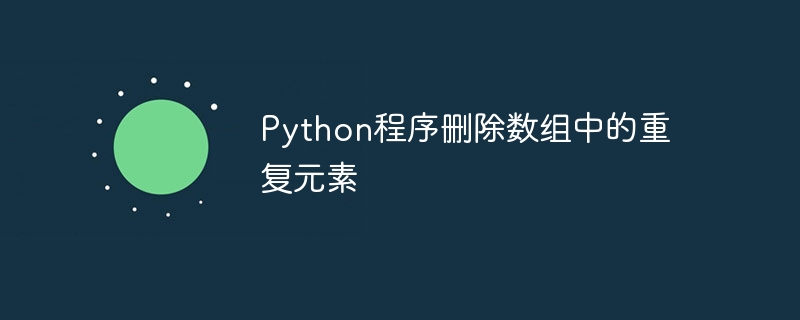

An array is a collection of elements of the same data type. Each element in the array is identified by an index value. It is one of the simplest data structures in which each data element can be accessed directly using only its index number.
Python has no specific data structure to represent arrays. Here we can use List an array.
[6, 4, 1, 5, 9] 0 1 2 3 4
Indices in Python start from 0. In the above code block, the integers 6,4,1,5,9 are array elements and 0,1,2,3,4 are their respective index values.
Arrays can have duplicate elements. In this article, we will discuss several ways to remove duplicate elements from an array.
Suppose we have an input array containing duplicate values. And the resulting array will contain only unique elements.
Input array: A = [1, 5, 3, 6, 3, 5, 6, 1] Output array: [1, 5, 3, 6]
Elements 1, 5, 3, 6 are the only elements in the given array.
We will use a for loop to iterate over all the array elements and in each iteration we will use the not in operator to find duplicates.
In this example, first we initialize an empty list result to store all the unique values found in the for loop.
lst = [1, 5, 3, 6, 3, 5, 6, 1]
print ("The original array is: ",lst)
# Remove repeated elements from array
result = []
for i in lst:
if i not in result:
result.append(i)
print ("The array after removing repeated elements: ", result)
The original array is: [1, 5, 3, 6, 3, 5, 6, 1] The array after removing repeated elements: [1, 5, 3, 6]
The "not in" operator is checking whether the current element exists in an empty list. If it does not exist, the element is appended to the result list, otherwise it is ignored.
Set is a data structure in Python that stores unique data. This means, it does not allow storing duplicate elements.
In this example, we will simply convert the array from a list data type to a collection data type.
lst = [1, 5, 3, 6, 3, 5, 6, 1]
print ("The original array is: ",lst)
# Remove repeated elements from array
result = list(set(lst))
print ("The array after removing repeated elements: ", result)
The original array is: [1, 5, 3, 6, 3, 5, 6, 1] The array after removing repeated elements: [1, 3, 5, 6]
As we all know, duplicates cannot be accommodated in a collection data structure, so we get an output array containing all unique elements.
Enumerate() is a Python built-in function that accepts an iterable object and returns a tuple containing the count and values obtained by iterating the iterable object.
enumerate(iterable, start=0)
We will implement the enumerate() function in the list comprehension to keep track of the index of each element in the array, and then we can use the index value i to check whether element n is already present in the array up to index i. If it exists, we ignore the element, otherwise we add it to the resulting array.
lst = [1, 5, 3, 6, 3, 5, 6, 1]
print ("The original array is: ",lst)
# Remove repeated elements from array
result = [i for i, n in enumerate(lst) if n not in lst[:i]]
print ("The array after removing repeated elements: ", result)
The original array is: [1, 5, 3, 6, 3, 5, 6, 1] The array after removing repeated elements: [1, 5, 3, 6]
python dict.fromkeys() method is used to create a dictionary based on the given set of keys and values. Dictionaries store a unique set of keys.
dict.fromkeys(keys, values)
Keys - This is a required parameter. It takes an iteration to specify the keys of the new dictionary.
Values - It is an optional parameter, the values of all keys. The default value is "None".
In this example, we will create a dictionary containing only keys, not key and value pairs.
lst = [1, 5, 3, 6, 3, 5, 6, 1]
print ("The original array is: ",lst)
# Remove repeated elements from array
result = list(dict.fromkeys(lst))
print ("The array after removing repeated elements: ", result)
The original array is: [1, 5, 3, 6, 3, 5, 6, 1] The array after removing repeated elements: [1, 5, 3, 6]
As we all know, the keys in the dictionary cannot be repeated. Therefore, the fromkeys() method removes duplicate values on its own. Then we convert it to a list to get an array containing all unique elements.
These are some of the methods by which we can remove duplicate elements from an array.
The above is the detailed content of Python program to remove duplicate elements from array. For more information, please follow other related articles on the PHP Chinese website!




